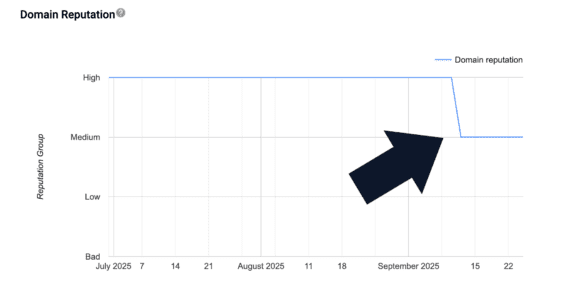E -mail traders will lose access to the two best delivery indicators on September 30, 2025, when Google will take the honorable version of 1 of its Postmaster tools.
Two messages that they are early-gone are domain reputation charts. Each offered to traders a simple indication of whether Gmail had marked messages as spam.
Favorite signals
The IP reputation chart showed red, yellow and green stripes, similar to traffic lights, visually, showing whether or not the sending address of the IP has been well recognized.
Both charts – IP and domain reputation – provided uncomplicated indicators of delivery e -mail. If their IP reputation and “high” domains were in Postmaster Google instruments, the sender knew that their messages would reach the Gmail post office.
The IP reputation chart was similar to the traffic light. Green is good.
Unfortunately, simplicity sometimes leads to complexity. For example, how can the sender restore the reputation of his domain if he has fallen from high to high school?
Finding an answer in Postmaster Tools V1 required visit to other messages such as proven traffic, encrypted operation and spam rate. The trader could use different tables and graphs for hypothesis and then take steps.
The identification of the problem was relatively complicated, but experienced e -mail delivery experts could usually discover and fix the problem.

A simple interface works well when everything goes smoothly, but what if the reputation of the domain drops from high to medium? What was the cause?
Compliance
In March 2024, Google released version 2 Postmaster Tools, the first significant change in almost ten years.
Version 2 contained a consistency control panel that provides simple green or red control to indicate whether the sending domain meets the Gmail e -mail instructions.
The “harmony” is not as clear as the reputation of the IP and the domain, but the control panel was a useful start, when we say, open and clicked rates decreased. Professional delivery deliveries could usually discover and correct problems, such as the slow logout process.
Understanding compliance with regulations
When the IP and domain reputation and domain charts disappear September, e -mail traders will have to understand the compliance with the regulations.
One way to approach this report is to divide it into technical inspections and aspects of behavior.
Technical
Six requirements of the statement of compliance status focuses on the technical settings of the domain: either suits or not. Green means “meets the request”.
- Implemented by SPF and DKIM verification. The Framework Policy of the Sender (SPF) and Domains identified by Mail (DKIM) prevents spammers from sending unauthened messages.
- “From:” The header corresponds to SPF and DKIM. E -mail “Z:” Header tells the recipient who sent the message. The requirement is to align this header with SPF and DKIM records.
- Implementation of DMARC authentication. Verification, reporting and conformation of domain-based messages (DMARC) instructs e-mail servers on how to handle SPF or DKIM failures.
- TLS encryption. The sender uses a cryptographic security protocol of the transport layer (TLS) to protect the content of messages.
- Implected forward records and DNS back records. The IP address must have a PTR (Reverse DNS) record that moves to the host name and that the host name must have the corresponding DNS (or AAAA) in advance to the same IP.
- Implemented on one click on the logout. Recipients can easily log out of the list.
Failure to observe any of these requirements affects the delivery of e-mail. In the postmaster Tools V1, errors could generate the “medium” for the reputation of the domain. They are clearer in V2.
Behavioral
The remaining two requirements for compliance with regulations affecting the mass sender of the e -mail, such as electronic traders, are related to behavior.
- The spam level given by the user below 0.3%. The passage score is less than 0.3% of recipients. However, the best sender is below 0.1%
- Honor logs off in 48 hours or less. Recipients who click on the login link should stop receiving messages from this particular sending address.
The first of these requirements measures the behavior of subscribers. How much did the message marked as spam?
The second has a technical aspect, but is also dependent on the sender’s practices. For example, a common problem with honor is to use a single sending address.
Imagine a merchant with a -mail newsletter, a promotional list (e -mail marketing) and transactional automation of e -mails. If everyone uses the same sending address – eg email@example.com – the recipient could unsubscribe from one list but still receive two more. Gmail would conclude that the sender had not touched the logout.

Knowing that the domain is not compatible, helps to identify what steps to remedy the problem.
In short, the depreciation of Postmaster V1 instruments means the end of the magic era. Many e-mail traders have become accustomed to logging in and seeing a simple color-marked bar for “Domain Reputation” and “IP reputation”.
The new version reflects the recipient’s interaction and objective sending standards.

